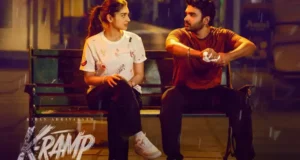 It’s not over-the-top like Dabangg. It’s not puerile like Rowdy Rathore. Saif Ali Khan has no gimmicky lines like aata majhi satkali in Singham. In a special dance number Mahie Gill does not let hang lose everything there is, just to woo front benchers. Bullet Raja attempts to reach out to large numbers just like the above mentioned 100-crore earners. Yet, in its quest to grab more eyeballs director Tigmanshu Dhulia’s film does not sacrifice a certain essence that you have come to associate with his recent films (Saheb Biwi Aur Gangster, Paan Singh Tomar, Saheb Biwi Aur Gangster Returns).The result is a des-chic, guns and gore affair, set against the backdrop of conniving UP politics and mafia.
It’s not over-the-top like Dabangg. It’s not puerile like Rowdy Rathore. Saif Ali Khan has no gimmicky lines like aata majhi satkali in Singham. In a special dance number Mahie Gill does not let hang lose everything there is, just to woo front benchers. Bullet Raja attempts to reach out to large numbers just like the above mentioned 100-crore earners. Yet, in its quest to grab more eyeballs director Tigmanshu Dhulia’s film does not sacrifice a certain essence that you have come to associate with his recent films (Saheb Biwi Aur Gangster, Paan Singh Tomar, Saheb Biwi Aur Gangster Returns).The result is a des-chic, guns and gore affair, set against the backdrop of conniving UP politics and mafia.
Bullet Raja follows the trajectory of a simple, unemployed, Brahmin man Raja Mishra (Saif Ali Khan), who is almost about to take up a job in a hotel that asks him if he has a hotel management degree. A series of untoward incidents in his life forces him to take the law in his own hands. Soon the simple youth transforms into a dreaded UP gangster, who lives life by his own rules. In the course of things he proves to be a loyal friend to Jimmy Shergill and his heart beats like never before for the 156th girl (Sonakshi Sinha) he meets. In his rise to power he is supported by a local politician (Raj Babbar) who ultimately wants to get rid of him. Sadly, Raja loses his dear friend which leads him to vent, “Bhai mara hai hamara, badla lena parampara hai. Koi corporate culture nahin hai ki agli deal mein adjust kar lenge.”
In the battle to avenge his friend’s death the film travels from Uttar Pradesh to Mumbai to Kolkata. The production design is such that it captures authentic milieu and details of all the three places, keeping it real at all times. The background score by Sajid-Wajid succeeds in producing the intended result at various junctures in the film. The action sequences are well-choreographed and thankfully it’s mostly kept real.
The writing is sharp, the scenes are well-constructed and the dialogue is superb without being overtly bombastic. Sample Saif saying, “Maa ne kaha tha beta kisi ka dil na thodna. Toh humne dil ko chodke sab kuch thoda”. On another occasion when Jimmy meets Saif for the first time in a wedding function at his house, he breaks the ice with Saif by asking him, “Halka paani (sherbet) peeyengey ya kuch bhadkila (alcohol) pasand karengey?” Or even when Saif mouths a line like “Brahmin bhookha to Sudama, rootha toh Ravan”. A simple line which easily indicates the storm that will, in due course of time, hit the small town. Sajid-Wajid’s music though not extra-ordinary fits in seamlessly into the texture of the film. Be it an item number that takes place in UP or the romantic track that occurs on the tram in Kolkata.
Dhulia unveils a narrative over which he has remarkable control. He captures the political-industrial nexus with necessary economy of scenes. He depicts the procession scenes, the market place or the ghat scenes with a disarming honesty for the real. Watch out for the excellently devised earthy kabbadi scene of Ravi Kissen in a mini-amphitheatre kind of indoor location. At the same time he imbues his lead protagonist with a rustic panache which is in contrast to the uber cool, urban image Saif has, by and large, had in most films. However, the Chambal dacoit scene seemed hurried. While it serves the purpose of introducing Vidyut Jamwal’s character, the guy who played the chief dacoit does not strike you as somebody tough-violent to deal with. He comes across as a mouse, dreaming of Bipasha Basu with only four henchmen around him.
To his credit Saif does justice to his role, bringing to it a vital spark and zest that flows so effortlessly. Sonakshi Sinha in a brief role does what is required for the part. She particularly impresses you with the Kolkata portions of her part. Particular mention has to be made of Vidyut Jamwal who demands your attention with his screen presence in the second half. His stunts, designed by himself are brilliantly executed. Both Gulshan Grover and Ravi Kissen impress in their small but effective roles.
Bullet Raja’s slogan claims “aayenge toh garmi badyaenge.” To the film’s credit it delivers what it promises. SCR-india today
 TeluguNow.com Telugu cinema news, Movie reviews, Telugu Movies Updates, OTT News, OTT Release dates, Latest Movie reviews in Telugu, Swathi weekly, Telugu cinema reviews, telugu movie reviews, Telugu Actress Photos, Telugu Movie HQ Photos, Tollywood, Box office collections, Telugu Movie show times, Theater List, telugu cinema tickets
TeluguNow.com Telugu cinema news, Movie reviews, Telugu Movies Updates, OTT News, OTT Release dates, Latest Movie reviews in Telugu, Swathi weekly, Telugu cinema reviews, telugu movie reviews, Telugu Actress Photos, Telugu Movie HQ Photos, Tollywood, Box office collections, Telugu Movie show times, Theater List, telugu cinema tickets



